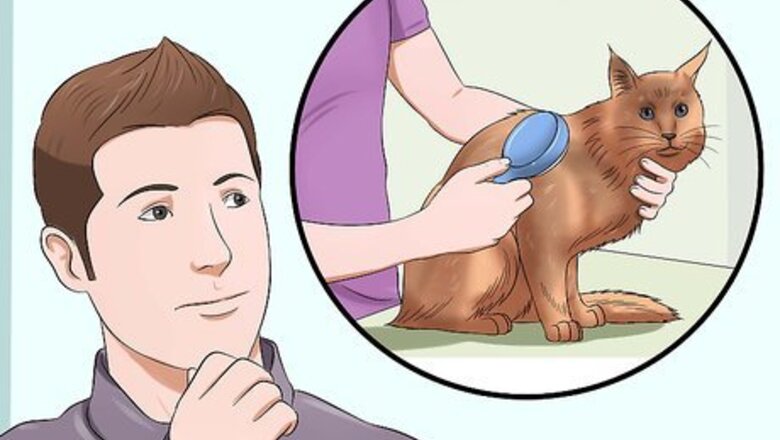
views
X
Trustworthy Source
American Society for the Prevention of Cruelty to Animals
Leading organization dedicated to the prevention of animal cruelty
Go to source
Keeping an Eye on Your Cat's Coat
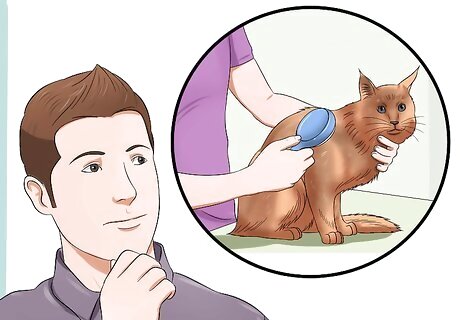
Practice matted hair prevention from early in your cat's life. Many people have problems because they didn't groom their cat's coat in earlier life, because it wasn't necessary to do so. However, as the cat gets older and needs a little help, they are unfamiliar with what you are trying to do and can resent the tugging and pulling on their skin. The cat then hisses or spits, and it can become dangerous to continue. In an ideal world you would plan ahead and get the cat used to being groomed and accept it as a pleasant experience from kittenhood. This involves short daily grooming sessions accompanied by lots of praise and a treat or two. Kittens under around 18 weeks of age are receptive to new experiences so the more she is brushed before she reaches this age the more she accepts it as normal.
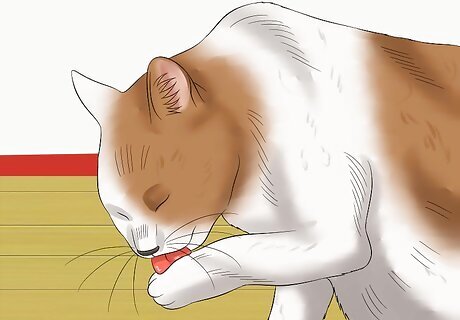
Make sure that your cat is grooming itself effectively. Cats shed hair all the time. Mostly the cat grooms out the shed hair or else it is rubbed off on your sofa and clothes. However, older cats that are arthritic and stiff, can have difficulty turning around to get to all parts of their body. This means the shed hair doesn't get shifted and sits in place clogging up the rest of the coat. You can usually tell if your cat has this problem because the coat has a "felted" appearance and is dull. If you grasp some of the hair tips in the felted area and pull gently the hairs come away painlessly.
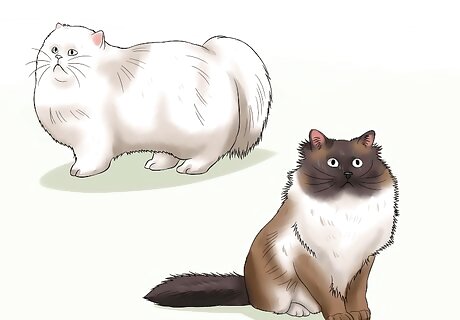
Keep a close eye on cats with long hair. Long-haired cats usually have a soft coat that is subject to static and tangles easily. The first places to get knotted are those areas where fur rubs on fur, such as in the armpits, between the back legs, under the chin, and behind the ears. However, when the cat curls up to sleep the fur can also mat up. Certain breeds of cats, including Persians, Birmans and Himalayans, have silky, fine hair that is especially prone to matting. Pay extra close attention to brushing and grooming these breeds and other long-hair cats.
Grooming to Prevent Mats
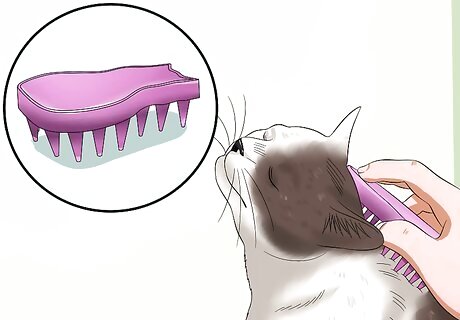
Use the correct tools to groom a short-haired cat. For short haired cats, invest in a Zoom Groom type tool or a rubber hand mitt. The Zoom Groom is designed to mimic the motion of a cat being licked by another and cats find this very pleasant and indulgent. The Zoom Groom is a rubber grooming tool that draws out shed hair from the coat by gentle friction, much as a tongue pulls out the dead hair. Many cats will purr ecstatically while they have a Zoom Groom spa treatment and this is a great way to keep a short-haired cat's coat from becoming knotted. It also has the advantage that the grooming tool is soft and so there are not hard metal teeth to catch against sore joints and hurt the older arthritic cat. Start using one in kittenhood and not only will the cat look forward to his or her daily grooming sessions but it will have a luxuriously glossy coat to boot.
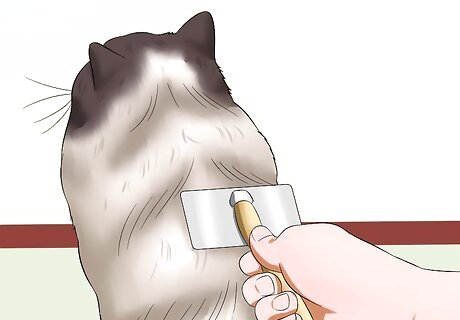
Use the correct tools to groom a long-haired cat. Invest in a well-made cat rake and long-tooth comb to properly help prevent matting. Rakes have short, sturdy bristles that are usually made of metal and are good for brushing dense, long hair. Long-tooth combs allow you to comb deep into your long-haired cat's fur and comb through small mats before they get too large. Both items can be found in pet and retail stores. Use the comb first, gently combing through the coat much as you would comb through your hair to tease out any tangles. Grip the knot between finger and thumb and work above your fingers so that you are not tugging on the skin. Start at the top of the knot (the end furthest from the skin) and gently separate the knot until it begins to part. Then work down a little deeper. Sometimes it is helpful to use your fingertips rather than the comb, to open up the mat. Keep working gently until the tangle is removed and you can comb through.
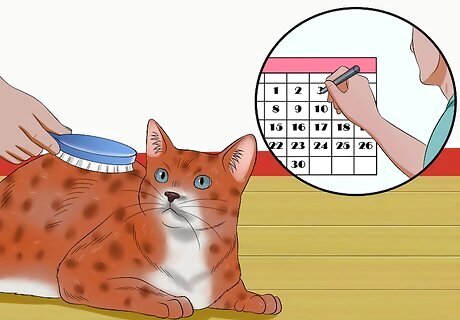
Groom your cat routinely. By grooming your cat every day you catch mats in the early stages, while they can still be untangled. Begin a regular brushing routine on your long-hair cat's coat before mats occur. Work with your long-hair or short-hair cat daily so he or she gets used to being brushed. If you get your cat as a kitten, start when he or she is young.
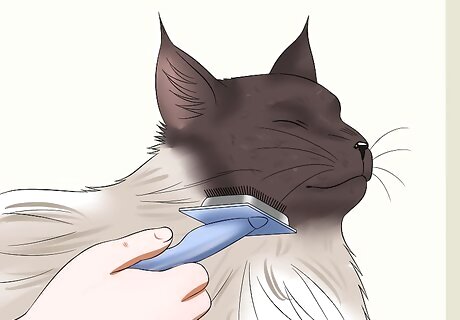
Be sure to comb the undercoat as well as the top coat. Run the rake deeply but gently in the underlying fur, called the undercoat ,where mats begin as tangles. Rakes penetrate down to the under coat and reach deeper than a Zoom Groom or rubber mit. The rake helps to remove shed fur from the soft undercoat, which is often where tangles start to develop.
Dealing with Cats that Don't Like Brushing
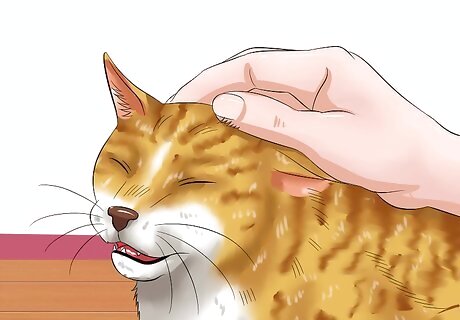
Acclimate your cat to touch. Many cats are hesitant to be brushed because they never became accustomed to being handled by humans. Slowly get your cat used to your touch by petting it for brief sessions every day. If your cat responds negatively to your touch, then you need to find another time in the day to pet it. Even a cat that doesn't like to be petted may have a time in the day when it is more open to it.
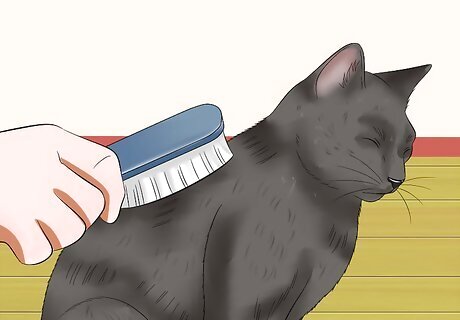
Brush slowly and gently. Brushing is the best method to avoid mats, so if your cat doesn't like being brushed you should try to get the cat used to it. Pet the cat until it is relaxed and hopefully purring. Let the cat sniff the comb and then gently pass the smooth side of the comb over the cat's coat, without putting the tines through your cat's fur. Swiftly follow the comb with your hand so the comb is almost indistinguishable from a stroke. Repeat this a few times, give the cat a treat and end the session on a high. Repeat this daily, twice daily if possibly, building up the cat's tolerance of contact with comb and having its body touched in general. This approach works best if the coat isn't tangled, since tangles equals tugging and soreness. Thus if the coat is already knotted consider getting the worst areas clipped away and then start getting the cat used to being brushed.
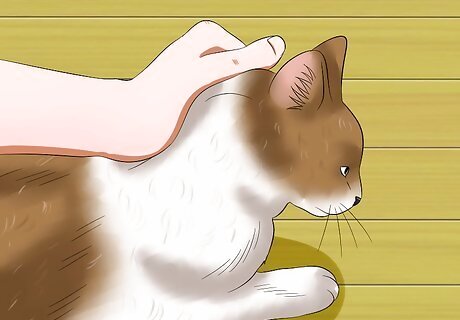
Scruff the cat if you cannot get it used to combing. If a cat hisses and spits, and yet you want to get rid of a stubborn knot before it causes a problem, consider scruffing the cat. To do this use your non-dominant hand to grasp the cat's scruff so that you can use your dominant hand to comb the cat through. This has a naturally subduing effect on the cat, as it's where the mother grips her kittens when carrying them. Never lift the cat off the ground completely, as this could injure an adult cat. Simply grip the scruff to stop the cat running away.
Eliminating Mats
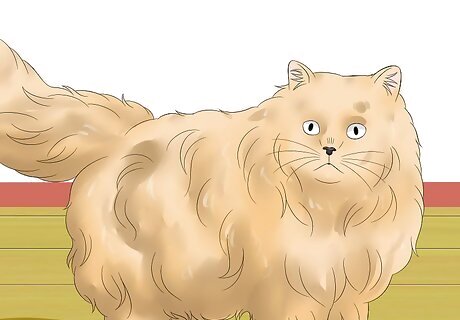
Identify cat-hair mats. You can tell if your cat has matts because the clumped fur is not painful when you touch it. If you work down to the bottom of the lump you can often see the individual hair fibers bridging between the skin and the mat.
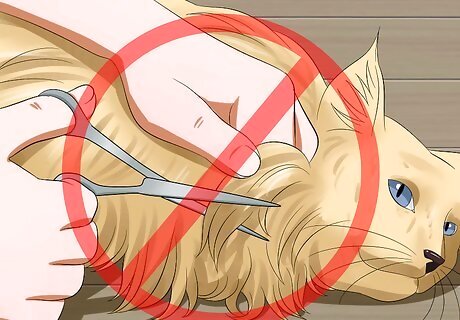
Avoid cutting out mats if possible. When mats do occur, they can be difficult if not impossible to comb out, resulting in the need to cut chunks of hair from your cat's coat. The cat's coat will then grow back uneven, and can take months to return to normal. Therefore, it is important to learn how to prevent matted cat hair before it happens to keep your cat looking and feeling his or her best.
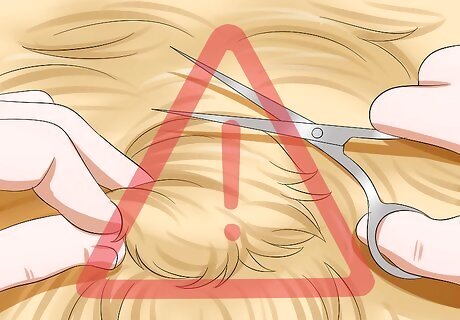
Be very cautious if you decide you need to cut out a mat. If you are unable to untangle a knot, then you may need to cut it away. Proceed with extreme caution because it is all too easy to accidentally cut the skin instead of the knot. This happens because when you lift up the knot to get it clear of the skin, the skin often "tents" upward with it. Then when you snip across the base of the knot you may cut across an elevated piece of skin.
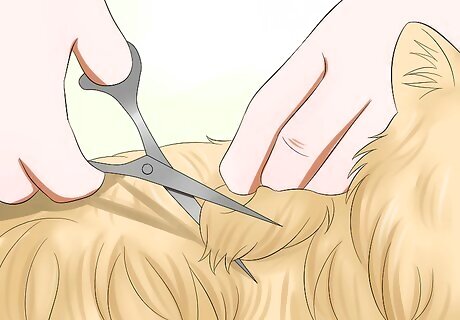
Cut thick, large mats out using small scissors. Try and slide a comb between the knot and the skin, and cut above the comb so that it acts as a shield protecting the skin. Pay close attention not to cut your cat's skin, especially in areas where the hair mats are close and tight.
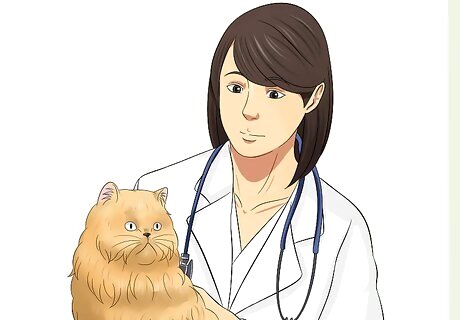
Take the cat to its vet when matting gets too bad. If you are nervous to cut out mats yourself, or if your cat is covered with mats, take it to its veterinarian. Above all, if in doubt do not cut. Take your cat to a vet clinic or a groomers where they have professional clippers that can shear away the knot with a reduced risk of cutting the skin. Your vet is probably very practiced at removing mats.
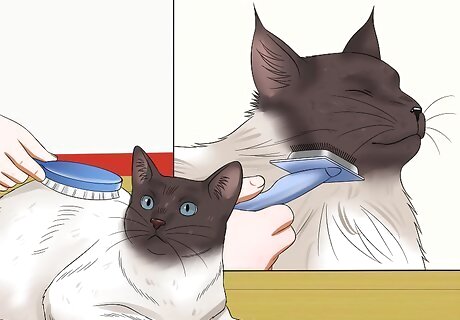
Brush thoroughly over the areas where matted cat hair was removed. This will help to prevent the area from matting again. If an area has been matted before, your cat will probably continue to neglect it. Make sure that you get all the way down to the undercoat and that you brush it out regularly.

















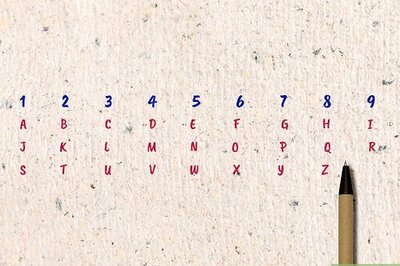

Comments
0 comment